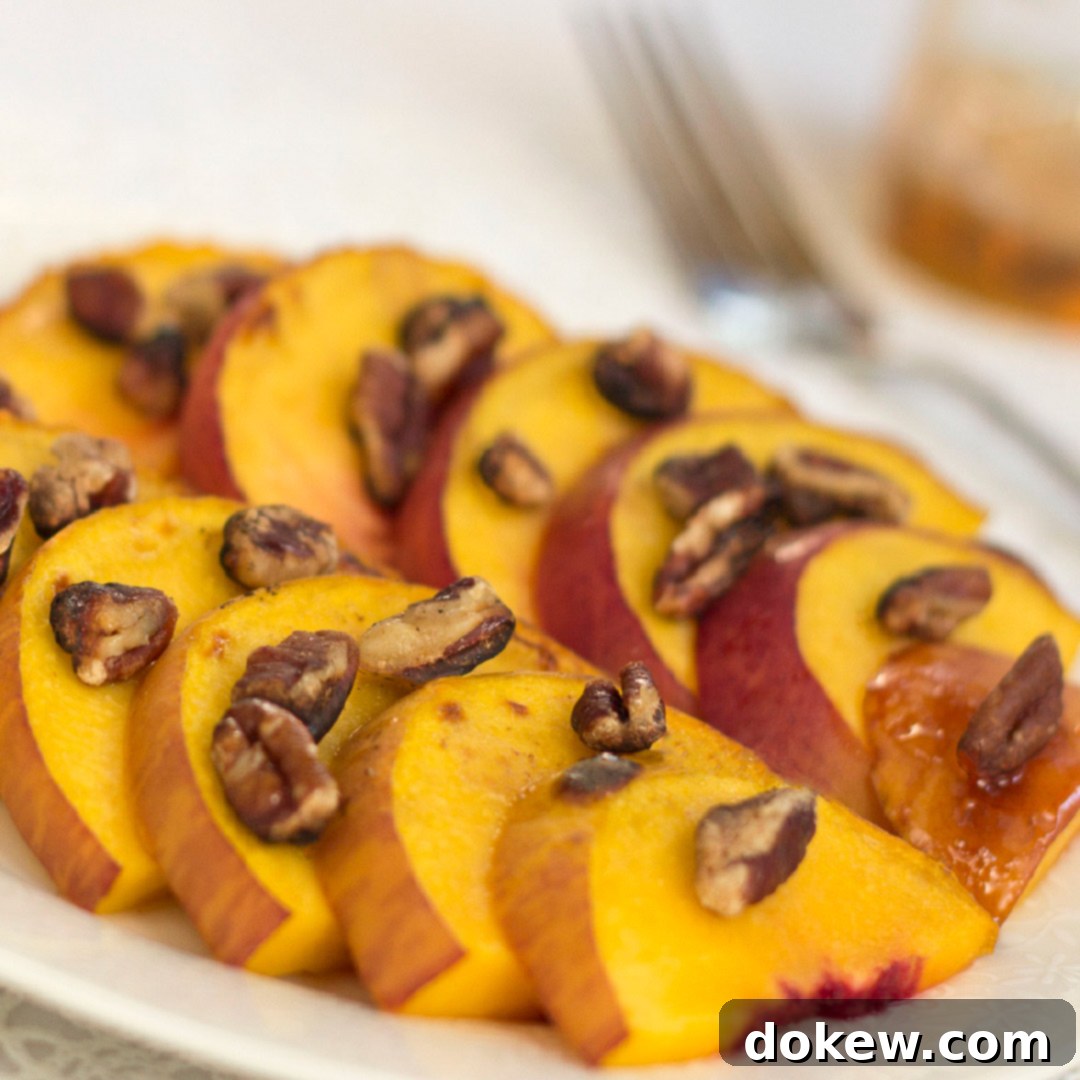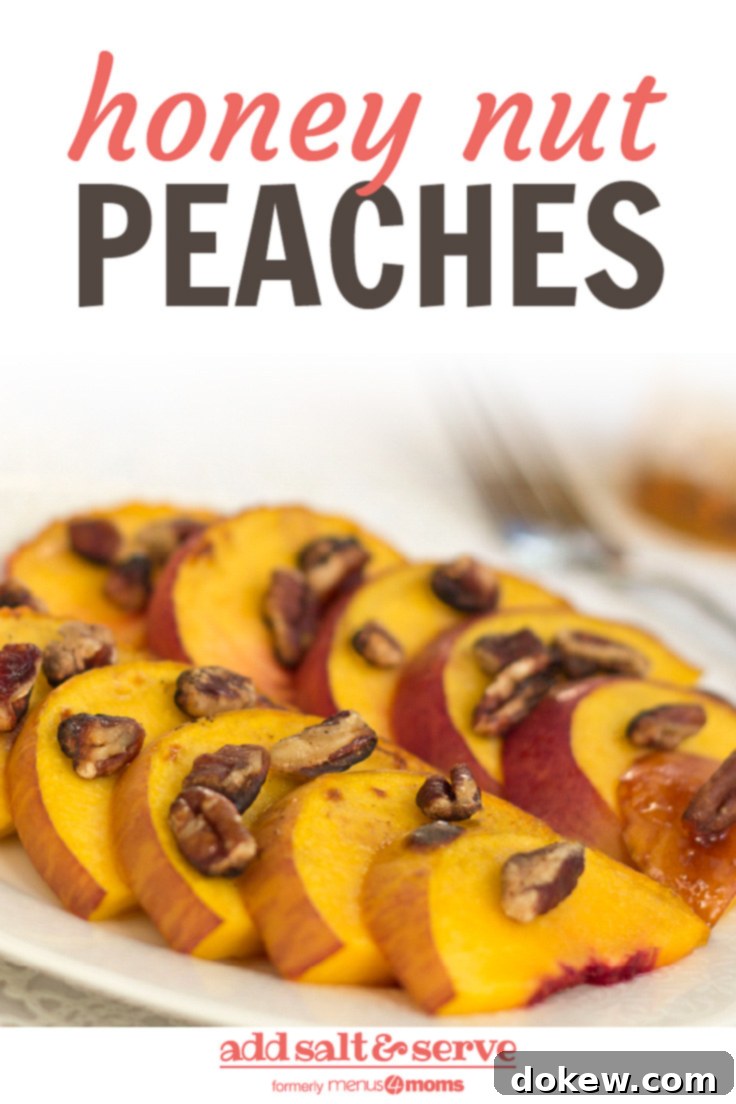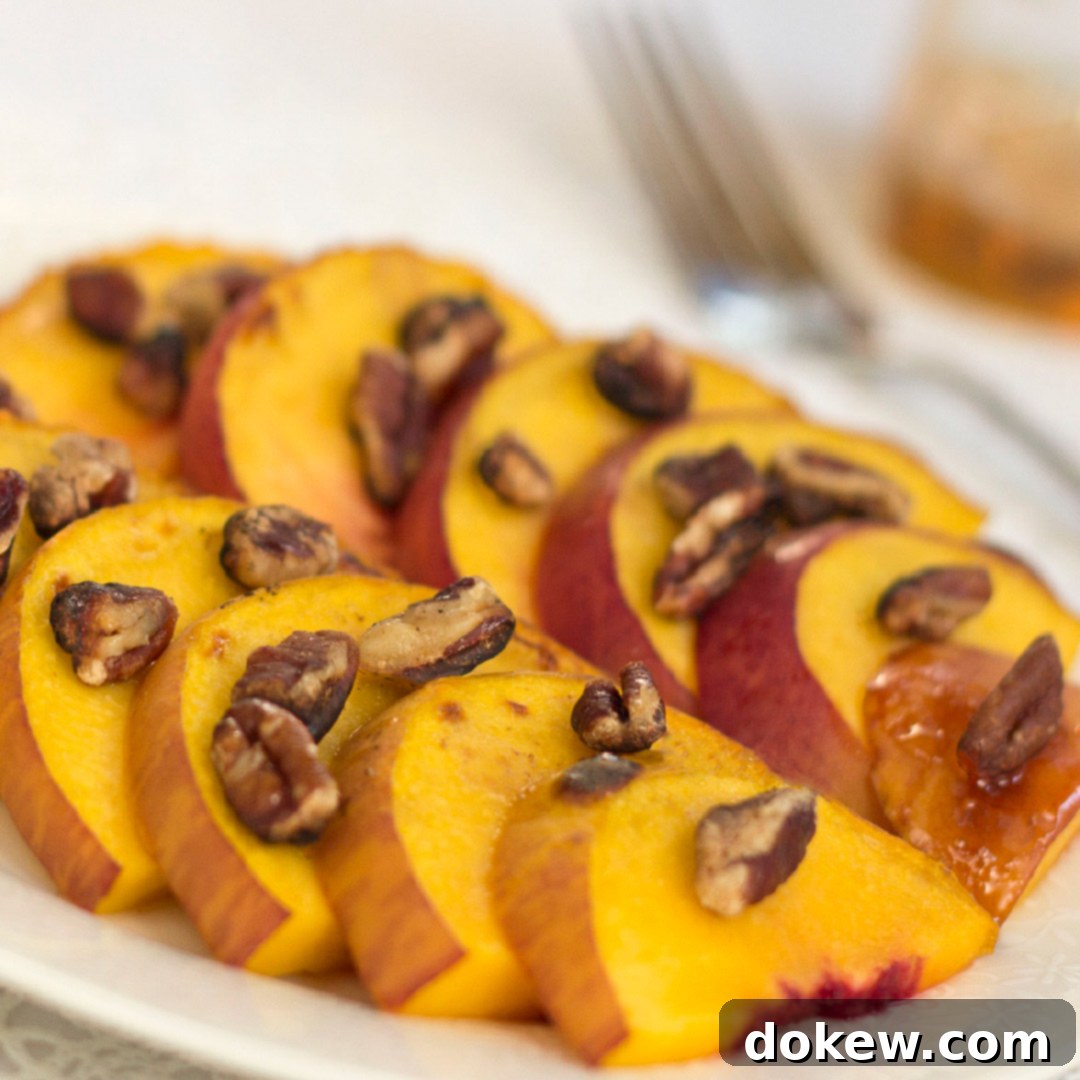Delicious Honey Nut Peaches: Your Ultimate Guide to a Quick & Healthy Summer Dessert
Embrace the true essence of summer with our delightful Honey Nut Peaches recipe. This simple yet elegant dish transforms fresh, ripe peaches into a warm, golden-hued delicacy, perfectly complemented by the crunch of pecans and a sweet drizzle of honey. As peaches flourish from mid-May through mid-August, the summer months offer the prime opportunity to savor these succulent stone fruits at their very best. Whether you’re searching for a light dessert, a wholesome snack, or an easy breakfast addition, these broiled peaches are a fantastic choice, ready in just 15 minutes. This recipe is also naturally gluten-free and vegetarian, making it a versatile option for various dietary needs.

Why You’ll Love This Honey Nut Peaches Recipe
There are countless reasons why these Honey Nut Peaches will become a summer staple in your kitchen. First and foremost, the recipe celebrates the natural sweetness of peaches, enhanced by a touch of honey and the earthy flavor of pecans. It’s incredibly quick to prepare, requiring only about 15 minutes from start to finish, making it an ideal choice for busy weeknights or impromptu gatherings. This dish is also wonderfully versatile; serve it as a standalone dessert, a side dish, or even an elevated breakfast item alongside yogurt or oatmeal. Plus, it’s a naturally healthy option, packed with vitamins, fiber, and healthy fats, without compromising on taste.
Understanding Peach Season: Sourcing the Best Fruit
To truly appreciate the flavor of this recipe, selecting the finest peaches is key. Peach season typically runs from mid-May to mid-August, though this can vary slightly based on your geographical location and the specific peach variety. During this window, local farmers’ markets and grocery stores are brimming with these succulent fruits. Opting for in-season peaches ensures maximum flavor, juiciness, and nutritional value. Common varieties include freestone peaches (where the pit easily separates from the flesh) and clingstone peaches (where the flesh clings to the pit). Both are delicious, but freestone varieties are often preferred for recipes that require slicing.
How to Select the Perfect Ripe Peach
A perfectly ripe peach is a culinary delight, offering a burst of sweet, aromatic juice. Knowing how to choose one can make all the difference in your recipe’s outcome. There are two primary types of peaches you’ll find in most markets: yellow peaches and white peaches. Yellow peaches are the more common and traditionally peachy flavored, while white peaches are increasingly popular for their delicate sweetness and lower acidity. Here’s how to assess their ripeness:
Judging Ripeness by Color
- The Golden Rule: Always focus on the ‘ground color’ of the peach – the yellow or creamy white color beneath any red blush. The red blush on a peach is simply a sun-kissed indicator and doesn’t reveal much about its ripeness or sweetness.
- For Yellow Peaches: The ground color should be a vibrant golden yellow.
- For White Peaches: Look for a creamy, off-white hue.
- Avoid Green: Never choose a peach with any green near the stem or across its skin. Green indicates that the peach was picked too early and will likely never fully ripen or develop its full sweetness and flavor.
The Feel Test
The texture of a peach is arguably the most reliable indicator of its readiness. When gently testing a peach, be careful not to press too hard, as this can bruise the delicate fruit. Hold the peach in the palm of your hand and gently cup it, applying minimal pressure:
- Ready in a Few Days: A peach that feels firm but has a slight “give” when gently squeezed is ideal if you plan to use it within 2-3 days. It will continue to ripen beautifully on your countertop.
- Ready to Eat Now: A peach that feels soft to the touch (but not mushy or bruised) is perfectly ripe and ready to be enjoyed immediately. These are fantastic for this broiled peach recipe.
The Smell Test
A ripe peach should smell as wonderful as you hope it tastes. Bring the peach close to your nose, especially near the stem end. A sweet, fragrant, and distinctly “peachy” aroma indicates a ripe, flavorful fruit. If there’s no scent, the peach is likely not yet ripe.
Tips for Storing Peaches for Optimal Freshness
Proper storage ensures your peaches remain delicious and extends their shelf life:
- Delay Washing: Always wait to wash your peaches until just before you’re ready to eat or use them in a recipe. Washing peaches prematurely can remove their natural protective coating, making them more susceptible to spoilage.
- Room Temperature for Ripening: Store unripe peaches in a single layer at room temperature on your countertop. This allows them to ripen naturally and develop their full flavor and aroma.
- Hasten Ripening: To speed up the ripening process, place peaches in a paper bag and roll the top down to seal it. The ethylene gas emitted by the peaches will concentrate in the bag, accelerating ripening. Check them daily.
- Refrigerate Ripe Peaches: Once your peaches have reached your desired level of ripeness, transfer them to the refrigerator. This will slow down the ripening process and extend their life for several days, preventing them from becoming overripe or mushy. Store them in a single layer to prevent bruising.
- Prevent Browning (Oxidation): Like apples, sliced peaches will begin to oxidize and turn brown when exposed to air. To prevent this, toss sliced peaches with a small amount of citrus juice, such as lemon or lime juice, or even orange juice. A fruit fresh product can also be used.
- Freezing Peaches: For year-round enjoyment, you can easily freeze ripe peaches. Peel and slice them, then arrange the slices in a single layer on a baking sheet and freeze until solid. Once frozen, transfer them to an airtight freezer bag or container. They can last up to 6-12 months and are perfect for smoothies, pies, or future broiled treats!
Health Benefits of Our Ingredients
This simple recipe is not only delicious but also packed with nutritional goodness:
- Peaches: Rich in vitamins C and A, peaches are also a good source of dietary fiber, promoting digestive health. They contain antioxidants that help protect the body against free radicals and support overall well-being.
- Pecans: These flavorful nuts are an excellent source of healthy monounsaturated fats, which can contribute to heart health. They also provide fiber, protein, and essential minerals like zinc and magnesium, and are loaded with antioxidants.
- Honey: A natural sweetener, honey offers antibacterial and anti-inflammatory properties. When used in moderation, it provides a gentle sweetness that is more complex than refined sugar.
Dietary Considerations
This Honey Nut Peaches recipe is incredibly accommodating for various diets:
- Gluten-Free: Naturally free from gluten, this dish is a safe and delicious option for individuals with celiac disease or gluten sensitivity.
- Vegetarian: Made entirely with plant-based ingredients (fruits, nuts, and honey), it fits perfectly into a vegetarian lifestyle.
- Vegan Option: To make this recipe suitable for a vegan diet, simply substitute the honey with an alternative liquid sweetener like maple syrup or agave nectar.
- Healthy Snack/Dessert: Low in calories and high in natural goodness, it serves as an ideal healthy dessert or snack without any guilt.
Honey Nut Peaches Recipe
This recipe transforms juicy summer peaches into a warm, delightful treat with minimal effort. It’s quick, healthy, and incredibly satisfying.
Honey Nut Peaches
Dress up fresh fruit with this simple recipe. Peaches are in season mid-May to mid-August depending on your location, so summer is the perfect time to take advantage of juicy, ripe peaches.
Author: Mary Ann
Prep Time: 10 mins
Cook Time: 5 mins
Total Time: 15 mins
Course: Dessert
Cuisine: American, Gluten-free, Vegetarian
Servings: 4 servings
Calories: 112 kcal per serving
Ingredients
- 3 small peaches, pitted and sliced
- 3 tablespoon chopped pecans
- 3 teaspoon honey
Instructions
- Prepare the Oven: Preheat your oven to a low broil setting. If your oven doesn’t allow for broil level adjustment, plan to place your broiler pan on a lower rack to prevent burning the fruit or nuts.
- Arrange Peaches: Carefully place the sliced and pitted peaches on a broiler-safe pan. Ensure they are in a single layer for even cooking.
- Drizzle and Sprinkle: Generously drizzle the honey evenly over the peach slices. Then, sprinkle the chopped pecans over the honey-coated peaches.
- Broil to Perfection: Place the pan into the preheated oven. Broil for approximately 5 minutes, or until the peaches are slightly softened and warmed through, the honey is bubbling, and the pecans are lightly toasted. Keep a close eye on them to prevent burning, as broilers can vary greatly in intensity.
- Serve Warm: Carefully remove the pan from the oven and serve your delicious Honey Nut Peaches warm. They are wonderful on their own or with your favorite accompaniments.
Notes
Choosing & Storing Peaches: Select ripe peaches by looking for a golden yellow (for yellow peaches) or cream (for white peaches) ground color near the stem, free of any green. They should feel firm but yield slightly when gently squeezed. Ripe peaches will also have a fragrant, sweet aroma. Store unripe peaches at room temperature. Once ripe, move them to the refrigerator to extend their freshness for a few days. To prevent sliced peaches from browning, toss them with a little lemon juice.
Nutrition per serving
- Calories: 112 cal
- Carbohydrates: 16 g
- Protein: 2 g
- Fat: 6 g
- Sodium: 1 mg
- Fiber: 2 g
- Sugar: 14 g
Enjoy this simple yet elegant summer treat. These Honey Nut Peaches are sure to impress with their ease of preparation and delightful flavor!
Share Your Sweet Success
We love seeing your culinary creations! If you enjoyed making and tasting these Honey Nut Peaches, please consider sharing your experience. Pin this recipe to your favorite Pinterest board to save it for later, or share it with friends and family on social media. Your feedback and shares help us bring more delicious and easy recipes to everyone!

